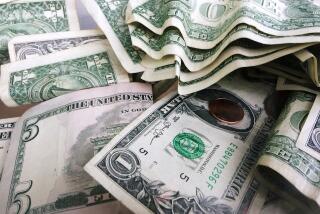Old Savings Bonds May Yield Treasure
Jack Quinn got interested in savings bonds several years ago when he found a forgotten stack of them in the bottom of a drawer.
Now, he runs a company that provides consumers with information about the venerable U.S. government savings program, which offers an investment that is widely misunderstood. And he’s urging Americans to search through their papers and safe deposit boxes to unearth old savings bonds as he once did.
The reason: An astounding $13.55 billion of the bonds have matured and are no longer earning interest. That means their owners are forgoing $405 million annually -- $1.1 million a day -- in income on this “matured” debt, assuming that they could have redeemed the bonds and reinvested the proceeds at 3%.
Moreover, ignoring the bonds could land them in trouble with the Internal Revenue Service, which expects taxpayers to pay income tax on accrued interest when the bonds mature -- regardless of whether they’ve been cashed in, Quinn said.
“All the bonds that people purchased during the heyday of the savings bond have started to come due,” he said, referring to the 1950s and 1960s, when buying the bonds was practically a patriotic duty. “But people don’t really understand this. Millions of people just bought them through payroll deductions; they didn’t really understand what they were buying then, so they don’t understand what they have now.”
In some cases, what they have is an investment that’s often worth more than it appears to be, he said.
Though savings bonds look somewhat like dollar bills, displaying an image of a historic person and a dollar value, they’re rarely worth precisely that “face amount.” Recently issued bonds are worth less than the value printed on the front, and old bonds, such as those that have matured, are often worth substantially more. The bonds mature in 30 or 40 years, depending on when they were issued.
Consider, for example, a $25 savings bond issued in May 1951. That bond -- despite the $25 value printed on the face -- could be cashed in today for $164.16 -- more than six times its face amount, Quinn said. A nearly identical bond issued 13 years later would be worth even more, he said: $234.11.
Why would a bond issued in the 1960s be worth more than one issued in the 1950s? It’s a function of the promised interest rate at the time they were issued, and rates were typically higher on the bonds from the 1960s.
Interest rates on older savings bonds floated with market interest rates. The higher the yield on other Treasury securities, the more interest that would accrue on savings bonds.
Older bonds promised minimum returns ranging from 4% to 7.5%. Interest accumulates on those bonds at either the minimum rate or the floating rate -- whichever is more -- for 30 or 40 years after they are purchased. (Since last May, all savings bonds have been issued with fixed rates.)
The government does not send statements advising savings bond owners what their bonds are worth or how much interest has accrued on a bond to date. Nothing on the bond indicates how much it’s returning in any given year either. Those who want to know have to investigate themselves. Too few do, Quinn maintains, leading many people to hold on to the bonds too long or dismiss them as being worth only their face values.
“People are sitting on fortunes and they don’t even know it,” Quinn said. “The face amount has nothing to do with the actual value of the bond.”
Quinn said he recently looked at a portfolio of bonds owned by family friends who had purchased the securities over time through payroll deductions. The portfolio, which appeared to be worth $60,000, was actually worth $120,000.
There are two ways investors can learn what their old bonds are worth, said Stephen Meyerhardt, spokesman for the federal Bureau of the Public Debt.
They can take them to a commercial bank that participates in the savings bond program, where they can also cash in the bond. Or they can check on the Treasury Department’s website at www.savingsbond.gov. In addition to savings bond tutorials, the site offers a savings bond calculator. To use it, plug in the bond’s serial number or issue date. It responds with the current value of that bond and the date that it will next accrue interest.
Quinn’s company, Spring Lake Heights, N.J.-based SavingsBonds.com, offers a similar free service at www.savingsbonds.com. He also offers, for $6 to $25 annually, a bond monitoring service that generates a monthly statement tracking an investor’s bond earned portfolio.
*
Kathy M. Kristof, author of “Investing 101” and “Taming the Tuition Tiger,” welcomes your comments and suggestions but regrets that she cannot respond individually to letters or phone calls. Write to Personal Finance, Business Section, Los Angeles Times, 202 W. 1st St., Los Angeles, CA 90012, or e-mail [email protected]. For previous columns, visit latimes.com/kristof.
More to Read
Inside the business of entertainment
The Wide Shot brings you news, analysis and insights on everything from streaming wars to production — and what it all means for the future.
You may occasionally receive promotional content from the Los Angeles Times.










